by Dr. Gil Dekel.
I have developed the Streaming Knowledge method (SKM) on the teachings of Dr. Amikam Marbach, Carl Jung and other scholars. The method helps people generate ideas, make effective literature search and write articles (or produce art works). SKM is versatile method since it tackles the initial universal stage of all creative processes: learning to ‘look inside’, draw ideas, and clearly define them.
Introduction:
Any academic research requires students to be organised, and to focus on clearly defined information. The Streaming Knowledge method (SKM) can help you organise your ideas, create specific keywords, and conduct literature research in the library or online. You can then construct articles or even create art-works based on your keywords.
SKM can be used in many ways. In this article I will focus on using SKM for writing and research skills, as well as for developing creative processes in art-making. I will focus on: words (conducting research and writing articles) and images (producing art works).
The problem students are facing when conducting research:
Many times students have intuitive ideas about what they want to research. Students then need to organise, define, and write the ideas down on paper (or create artworks based on the ideas). Here lies the problem: while many students have initial vague ideas, they do not know how to translate the ideas and construct them into an article. Intuitive ideas are not always concrete – we may have a sense or a direction of them, but not a definite formulation.
More so, if you go to the library with only a vague idea of your topic, you will come out with way too much information and books. It will be very difficult to limit the information available, and find the relevant articles. SKM provides a simple structure to help you define keywords which you will use when you conduct a research in the library (or online).
If you start your research by creating keywords (before you go to the library) you can then make specific dedicated search in the library using those keywords; and this will bring up only relevant articles. This process will minimise the content that comes up in your search results. SKM will also help you to structure your article once you have made your literature research, as the keywords will become the titles of the chapters in your article.
How to use the Streaming Knowledge Method:
Using the SKM template table, I ask my students to come up with a topic – just to say what interests them, without thinking about it for too long. If you need to write an article, we ask you to come up with a topic for your article; and we ask you do so immediately without reading the literature, without going to the library, without asking other people. We want you to look inside yourself, so to speak, and think with your intuition, very quickly. Just say what interest you, what you love in life, what is the first word that is coming up to your mind?
Then you will define the topic using one sentence. Defining something is saying the same thing using different words…
Then we ask you for three categories; three keywords that come from your topic and represent your topic. Categories are the ingredients of your topic.
If you are doing a PhD, you will go on to define sub-categories and sub-sub-categories by breaking each category into three, and then into nine. You will come up with an overall conclusion, based on your intuitive knowledge; and this will be the skeleton of your thesis. You have now created the basic structure of your research, even before visiting the library.
With this structure and keywords, you now go on to do your literature research.
Examples of the process:
I asked a student to come up with something that interests him, and he said: ‘a chair’. ‘Why a chair?’ You may ask… Well, because this student is interested in chairs; that’s what he likes to focus on. It has nothing to do with a ‘brief’, it has nothing to do with anybody else. You simply focus on what you personally like.
How would you define a chair?… an object used to sit on.
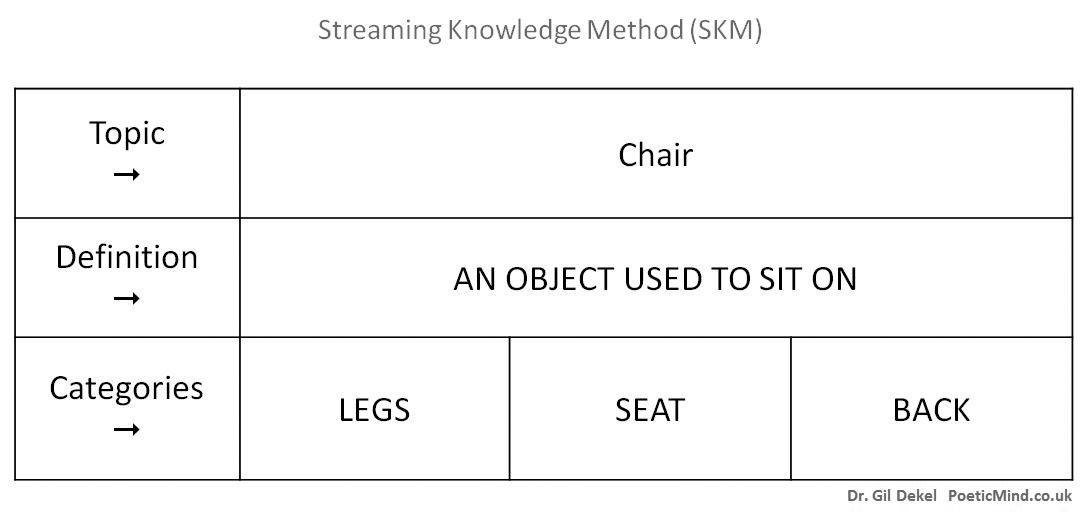
What are the three categories of a chair? the three things that a chair is made of, that constitute a chair? You can say: legs, seat and back.
The beautiful thing is that a different student would come up with completely different categories for the same topic of chair. Another student may not think of legs, seat and back – but wood, nails and varnish. This will make completely different article, a completely different outcome, using the same topic – chair (so don’t worry if you see someone doing the ‘same’ thing as you do; it’s not going to end up the same).
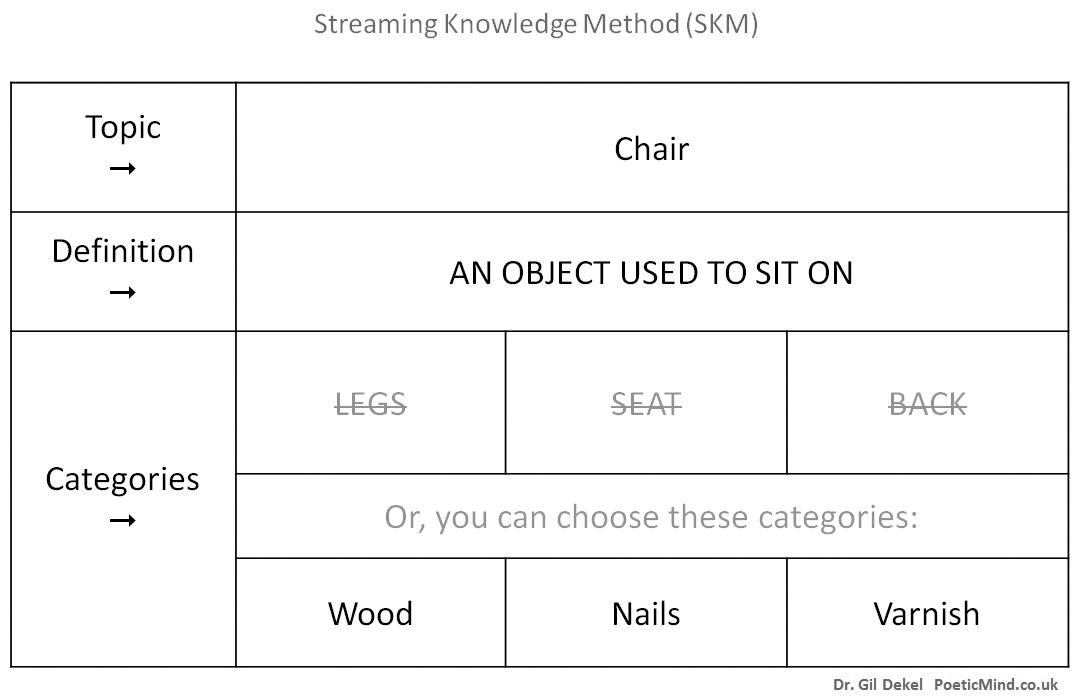
Another example: The topic is Tea. Someone can come up with three categories: leaves, cup, spoon. Someone else can say: grandmother, Brighton and seaside… When you tell them ‘tea’, they remember their visits to their grandmother who lives in Brighton and heaving tea at the seaside. So, there are many creative ways to go about it…
Once the table template is complete, only then you will go to the library and do your research. You go to the library with a ‘vocabulary’. You have keywords that are relevant to you, to what interests you, and that came from your own intuitive knowledge. The keywords are not ‘forced’ on you (which would make your research hard to complete and probably boring).
Next, you use your keywords for the search in the library. Use your keywords to type in the search box, and find relevant information.
Then you need to connect your keywords using quotes and ideas that you have found in the literature. Write one sentence, based on the literature, that explains the first keyword, and then another sentence that connects it to the second keyword. Continue in that way with the other keywords. The keywords (categories) are now becoming your three chapters in that way.
SKM for art-making:
The same keywords can also make-up three ideas or ‘ingredients’ for an art work. So, you can create a painting, design, photograph or sculpture – that is made of three items which are your three keywords. If the topic was a chair, then you can make a design or sculpture of piece of woods, nails and varnish (which were your three categories). You can dump wood and nails on a canvas, and cover them with a thick varnish. This can make an interesting sculpture/painting, which consists of the three categories of a chair. Since that will be an art-work, the result does not have to look like a chair. Yet, you have created an artistic interpretation of a chair…
You can produce both an artwork as well as article from the same categories keywords. You can now write an article about wood, nails and varnish, relating it to your art work, and referencing the topic which is a chair. It is good idea to write an article, even if you focus on making art works, simply because an article will clarify your ideas and make it easier for you to talk about your work, to explain it to other people, or to publish.
The initial process of research, writing articles, or making art, is similar. They all share the trait of knowing yourself, drawing inward to find your self-knowledge, and then bringing it out, translating it into communicative language – be it words in articles or images in art works.
SKM Selfie Collage exercise (you can do it yourself or in a class):
This is an exercise I do with students to produce simple articles as well as collages.
In this exercise I do give the topic (but if you have time you can let students come up with the topic themselves).
The topic I give student is: them; the work will represent them. So the article and the art collage they will create will be about them. It is always easy to do something about yourself, because you know yourself well.
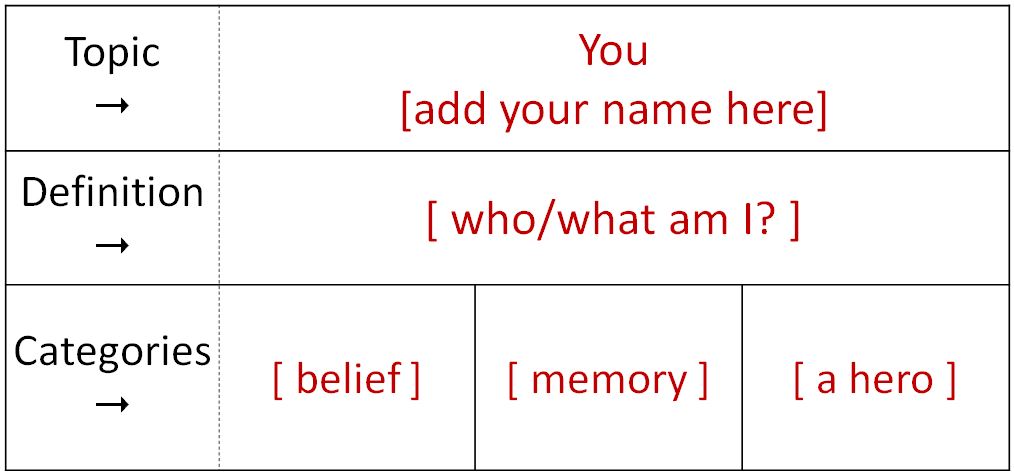
In the topic – students write their name.
Next, define who you are in one sentence…
Then write the three categories – I guide students with categories (but if you have time you can let them come up with categories by themselves). I ask that the first category has to be a belief they hold, any belief they have. The second category is a memory, and the third category is one of their heroes.
Here is an example of my SKM collage:
The topic is: Gil (my name).
Definition: if you ask me who am I, I would say that I ‘work’ for creativity and inspiration, so to speak. This is my life purpose, to increase creativity and inspiration in the world.
A belief: I believe in this thing called oneness; that we are all connected.
Memory: a memory that came to my mind was at the sea; I almost drowned when I was a child, and inside the sea I saw the water moving like a ‘waves’.
One of my heroes: Emanuel Kant; a great Prussian German philosopher.
Then the task is to make a collage from these keywords. A collage that represents the keywords. You can use magazines and journals for photos that relate, in a creative way, to the keywords. Be creative, and look for symbolism.
This is my collage:
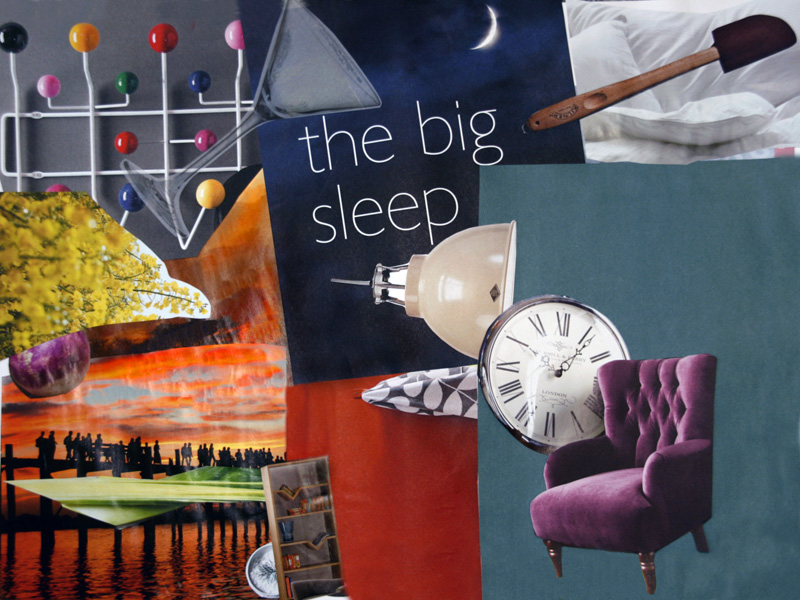
And this is how each photo represents the categories:
I happened to see a photo of coats hanger in a magazine, and it looked like people. Each coloured hanger is like a different person, and they are all connected. So this coats hanger represents the idea of ‘oneness’- which was my first category of a belief I hold.
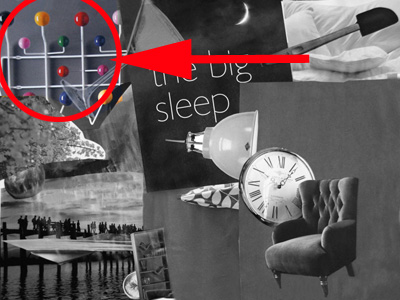
When I almost drowned as a child, there was a wooden pier next to me; it felt something like this photo. It may not look the same, but the ‘feeling’ coming from this photo is similar to what I felt then.
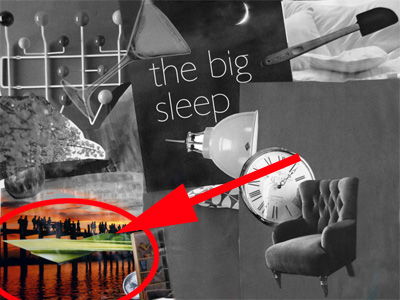
Inside the sea it felt like a big sleep because I was hovering inside the water.
It was very calm like pillows but very dangerous, which I represented in this sharp object over the pillows. So this represents my second category, which is a memory.
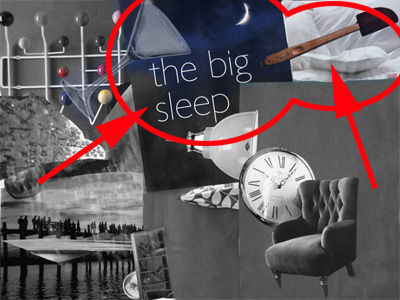
Emmanuel Kant is one of my academic heroes. This is last category. I saw this sofa photo and thought to myself that it would be great to be a philosopher sitting on such a sofa. This modern sofa has nothing to do with Emmanuel Kant, who lived some 300 years ago; but the feeling of a comfortable philosopher’s sofa made an association in my mind.
Kant was talking about time (this why I put a clock) and about space (this is why there is a lot of empty space around the sofa). Also, the bookcase photo has two shelves with beautiful triangle ‘indents’ coming down from the shelves (you can see it if you look carefully at the photo). Bookshelf is relevant (Kant wrote books), and the two ‘indents’ illustrates what Kant wrote about time and space. Kant talked about time and space as affected by the human mind. So in a way there is ‘indent’ or a ‘break-out’ to time and space concepts. Time and space are not ‘just’ out there is the world, but are also inside our psyche world. I felt that the shelves’ indents represent well the indents in time and space concepts, as Kant described.
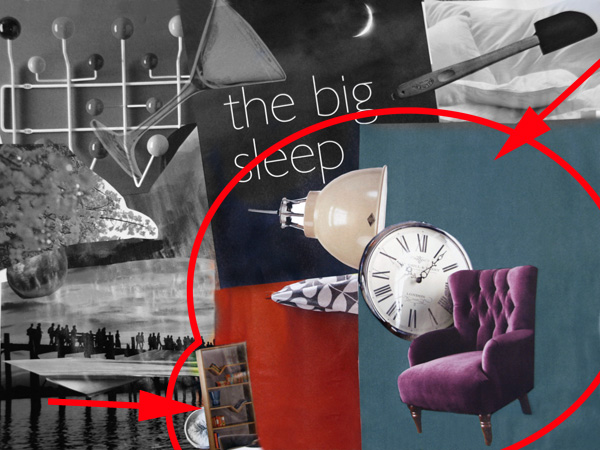
So, this is my SKM collage. It is relevant to me, which makes it very easy for me to describe and talk about. The photos illustrate and are coming out from the three categories. I also had the opportunity to perfect the final collage in Photoshop.
Once you create your key words (categories), you can create your collage, and then also write three paragraphs; one paragraphs for each keyword. Simply look at your collage, once ready, and describe it. Describe the photos, the associations, and their relevance to the key words. This is an excellent way to write articles.
If you need to write an article but are stuck, you can do a reverse process. Just grab hold of a few magazines, start cutting out images and laying them down in a collage. Once ready, look at the collage and start to make connections. This process will generate ideas and key words. You could then use the key words to start building up your article.
SKM is a great tool for writing as well as art-making. Download empty template table here.
© Gil Dekel
2 May 2015


 - Reading with Natalie, book here...
- Reading with Natalie, book here...